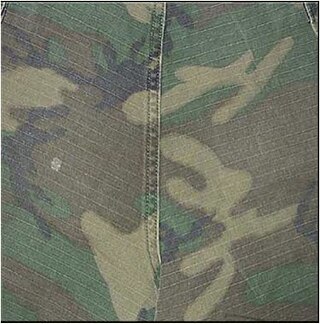United States Army Engineer Research and Development Laboratory
United States Army research facility (1947–1967) From Wikipedia, the free encyclopedia
The US Army Engineer Research and Development Laboratory (ERDL) was a United States Army Corps of Engineers research facility located at Fort Belvoir, Virginia.[1][2]
| Engineer Research and Development Laboratory | |
|---|---|
 ERDL (1948) pattern | |
| Active | 1947 - 1967 |
| Country | United States |
| Branch | US Army |
| Type | Military R&D organization |
| Garrison/HQ | Fort Belvoir, Virginia |
The ERDL performed research and development related to earthmoving, industrial engines and turbines, fuels handling, environmental control, electric power and propulsion, direct energy sources, detectors, bridges and marine craft, mine warfare, fortifications and obstacles, camouflage and deception, water purification, nuclear weapons effects, materials, and environmental testing.[3][2]
It also prepared procurement data, packages including development of specifications of materiel procured in quantity; engineering studies and tests to determine performance and quality assurance data for standardization documents; evaluation of unsatisfactory equipment reports and development of equipment modifications; tests of preproduction models, production samples and production sampling techniques; industrial engineering for all items of materiel; value engineering; product reviews; training literature and maintenance packages; initial production of new equipment procured in quantity.[3][2]
History
Summarize
Perspective
The Army established its first engineer board at Willets Point, New York, now Fort Totten, in 1870. Around the turn of the century, the engineer board was transferred to Washington Barracks, DC, where it was disbanded in 1920. It was replaced by the Board on Engineer Equipment, which was set up the following year in 1921, at Camp Humphreys, Virginia, now Fort Belvoir. This was the forerunner of the Engineer Board, which guided the research and development activities of the Corps of Engineers from 1933 to 1947. Initially, the Board occupied two temporary buildings near the present Wallace Theater. Its mission continued to expand, however, and the Engineer Board moved into the current facilities in 1942.[4]
The ERDL was formed in 1947 when, the Army's Engineer Board's laboratory elements were redesignated as the Engineer Research and Development Laboratories, or ERDL,[5][6][7] on 1 March 1947, in accordance with War Department General Order 26.[5] The Engineer Board, continued to function as the directive and policy-making body for the Engineer Research and Development Laboratories. The change in name was made to clarify the status of the scientists and technicians who conducted research and development work at the installation.[8][2][4]
By 20 October 1947, all functions of the Engineer Board laboratory elements had been transferred to ERDL. Under the new set-up, the ERDL was under the administrative supervision of the Director of Research and Development of the Engineering Center, operated through the Engineer Board, and technical supervision remained with the Office of the Chief of Engineers (OCE).[5][2]
On 1 August 1962, ERDL was released from assignment to OCE and transferred to the US Army Materiel Command (AMC), August 1, 1962, pursuant to Department of the Army General Order 46, dated 25 July 1962,[9] and further assigned to the US Army Mobility Command by AMC General Order 5, dated 26 July 1962.[9][10][2]
In 1966, ERDL transferred from US Army Materiel Command to the US Army Mobility Equipment Command (MECOM).[6][2]
Army Equipment Development milestones
Among other things, the ERDL was responsible for the creation of the ERDLator water treatment device in World War II, the ERDL woodland camouflage pattern in 1948, and the updated M1950 lensatic compass.[7]
The ERDL also established the first US Army research group dedicated to night vision systems in 1954, called the Research and Photometric Section.[11]
Mobility Equipment Research & Development Center
Summarize
Perspective
| Mobility Equipment Research & Development Center / Command | |
|---|---|
| Active | 1967 - 1984 |
| Country | United States |
| Branch | US Army |
| Type | Military R&D organization |
| Garrison/HQ | Fort Belvoir, Virginia |
In 1967, MERDC was established on 1 September 1967, when the US Army Engineer Research and Development Laboratories was redesignated as the US Army Mobility Equipment Research and Development Center (MERDC), in accordance of Department of the Army General Order 34, dated 28 August 1967.[12] MERDC also served as the Directorate of Research and Engineering for US Army Mobility Equipment Command.[13][2]
The center performed research, development and evaluation necessary for the procurement and support of the major mobility items managed by the command. In it, five assigned commodity groups—materiel transportation and handling, troop support, construction – and providing technical support and assistance to equipment users.[13][2]
In 1973, MERDC became an agency of the newly-formed US Army Troop Support Command (TROSCOM) and it remained part of TROSCOM until 1975, when the Center began to report directly to AMC.[14][2]
In 1976, the US Army Mobility Equipment Research and Development Center became the US Army Mobility Equipment Research and Development Command (MERADCOM)[6] on 23 January 1976, having been given full command status.[14][15][2]
In 1984, MERADCOM was disestablished on 1 March 1984, and its functions were divided between the newly established US Army Aviation Systems Command (AVSCOM) and US Army Troop Support Command (TROSCOM).[15] Around the same time, the Belvoir Research and Development Center was formed in its place.[6][2][16] Shortly afterward, the word "engineering" was added to its name.[4][6][2]
See also
Sources
External links
Wikiwand - on
Seamless Wikipedia browsing. On steroids.
